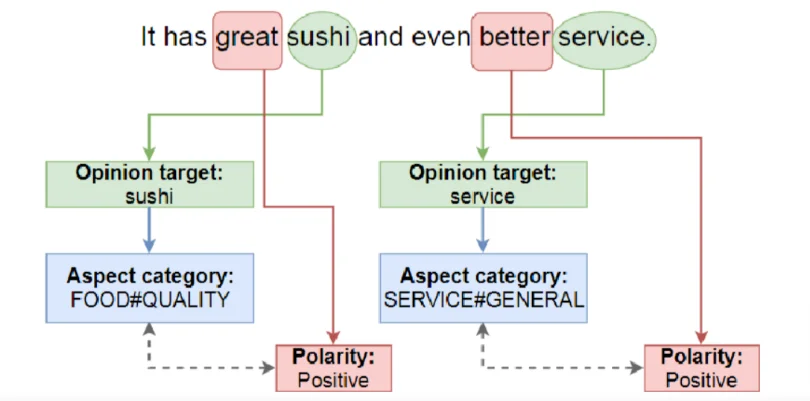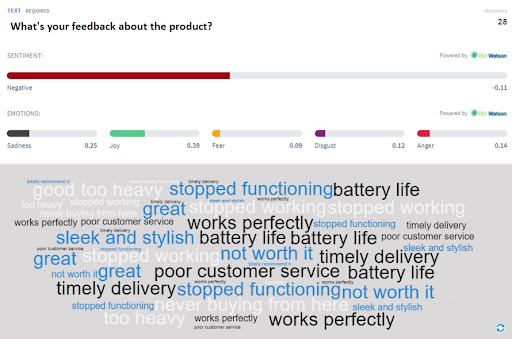
Wouldn’t it be great to have a magic spell that tells you the emotions of others?
We’re no Houdini, but we sure know the trick for this.
Ready?
Woosh!…enter Sentiment Analysis.
Creating an unforgettable customer experience and understanding customers’ sentiments go hand in hand.
If you know how customers feel about your brand, products, and services, you’ll be able to exceed their expectations.
But the need for such a tool becomes more obvious when you have a large data set and little time to analyze. It can help trim down the data analysis so you can focus on taking the right step to channel the insights.
The challenge is finding the right sentiment analysis model for your business. And there are a few considerations like the type of data set and budget.
That’s why we have this beginner’s guide to get started. We’ll uncover the different types of sentiment analysis techniques and models. We also outline the reasons that make such an NLP-based tool indispensable when it comes to customer insights and how you can leverage it to know your customers better..
What Is Sentiment Analysis?
Sentiment analysis, also known as opinion mining, uses natural language processing and text analysis to identify and extract qualitative insights such as customer emotions from reviews, social media posts, feedback from online surveys, and other online content.
Read Also: Qualitative vs. Quantitative Research: How to Get the Best of Both Worlds
The goal of sentiment analysis is to determine customers’ attitudes, opinions, and emotions regarding their experience with brands, products, and services. You can gather data in two ways:
Sentiment scoring: It’s where you assign scores to sentiment categories. For example, you can mark 1-star ratings as very negative and 5-star ratings as very positive, which you can further classify into specific emotions.

Aspect-based Sentiment Analysis (ABSA): This type of sentiment analysis captures customers’ sentiments towards a specific product or its features. For example, you can see comments and sentiments displayed toward a specific feature or product.

Why Leverage Sentiment Analysis for Your Business?
Sentiment analysis can be incredibly beneficial for businesses as it lets them gain valuable insights into customer opinions and emotions about the products or services. Here are a few key benefits of using NLP sentiment analysis for your business:
Improved Customer Service
Sentiment data analysis can help businesses identify and respond to customer complaints, feedback, and praise more effectively.
Suppose a customer complains on social media about a problem they had with a product. In this case, sentiment analysis can help you quickly identify the complaint and promptly respond to the customer.
In the same way, if a customer leaves a positive review about a product, sentiment analysis can help the business identify and acknowledge it.
By identifying and responding to customer feedback promptly and appropriately, sentiment analysis enables businesses to improve customer service and increase customer loyalty and satisfaction.
In simple terms, sentiment analysis is a way to listen and understand what the customers are saying about companies, so they can take action to improve their service.
Better Marketing Strategies
Businesses can use sentiment analysis to adjust their marketing strategies as per the customers.
For example, companies can track customer engagement on existing marketing campaigns on social media to see what kind of content is popular among the target audience.
Keeping an eye out on customer reviews and comments lets you spot customer and market trends and base your upcoming marketing campaigns on them. You can also look for mentions of competitors on social media to get the full picture.
Here’s an example of how understanding customer sentiment takes your digital marketing to a new level:
A travel agency Expedia Canada found out that one of its ads featuring violin music wasn’t a viewers’ favorite.
So, the agency acted on this insight with a humorous spin. It launched a new ad showing the violin getting destroyed beside its core messaging. It shows that the business isn’t complacent and listens to what customers say and feel.
Managing Brand Experience and Reputation
Timely monitoring of your customers’ opinions, experience, and feedback is a great way to improve your brand experience and maintain a positive reputation constantly.
For example, you can deal with negative reviews and complaints in real time before they spread and do irrevocable damage.
Multilingual Insights
Sentiment analysis provides valuable insights into multilingual customer behavior and preferences by analyzing the language used in customer interactions.
For example, if a company has customers who speak multiple languages and receives feedback in different languages, sentiment analysis algorithms can be used to analyze the sentiment expressed in each language.
The analysis can reveal customer data from different ethnicities, geographies, and regional differences in customer opinions. For example, a product is highly favored in one country but less in another. All this helps the company tailor its marketing efforts and boost customer satisfaction.
Here’s another example: if sentiment analysis shows that customers in Italy have a higher positive sentiment towards a product than customers in France, the company may decide to increase its marketing efforts in Italy to capitalize on this opportunity.
Real-Time Sentiment Tracking
With NLP sentiment analysis, you can also track customer emotions during live interactions, such as live feeds on social media, corporate events, promotional seminars, and more. This way, you don’t miss out on customer insights and target audience shares in live chats during live broadcasts.
Overall, sentiment data analysis is valuable for businesses that want to understand their customers better and make data-driven decisions.
3 Sentiment Analysis Models: How Do They Work?
Sentiment data analysis works on Machine Learning algorithms with several analytical models to implement from. Each model analyzes the data differently to give rich and accurate insights. Here are the approaches you can implement to perform sentiment text analysis of your data.
Rule-Based Sentiment Analysis Model
Rule-based NLP sentiment analysis categorizes text into negative, neutral, or positive sentiments and finds polarity, subjectivity, and the subject based on predefined, human-made linguistic rules and patterns.
For example, you want to analyze this sentence – “I love the XYZ feature.” We can create rules that identify positive words like “love,” which will categorize the sentence sentiment as positive.
Similarly, we can define rules for negative words, such as “hate” or “Unimpressive,” and categorize the sentiment as negative.
The fundamentals of rule-based sentiment analysis depend on several Natural Language Processing techniques in computational linguistics like tokenization, stemming, parsing, lexicons, and part-of-speech tagging.
Here’s an example:
Suppose you create two polarized sentiment categories: Positive with words like best, awesome, incredible, worthy, good, etc., and Negative with vocabulary like worst, horrible, not recommended, missing, etc.
So, the rule-based algorithm will count the frequency of both category words used in a sentence to determine if the sentence is positive or negative.

Its drawbacks:
- Although this method works, it isn’t the most accurate when the sentiment analysis data is contextual or complex.
- This system needs fine-tuning to take into account idioms, sarcasm, and other verbal semantics for analysis.
Automated Sentiment Analysis Model
In the automated process, a machine-learning-based computer model is fed feedback data in natural languages, such as survey feedback or reviews that are manually tagged with emotion labels. It studies words and assigns sentiment to them.

Unlike the rule-based model, this model doesn’t require human-made rules. It learns from the data fed into the system. And once it has sufficient data, it can automatically analyze new sentient analysis data sets effectively.
While considering sentiment analysis for your business, it’s best to use automated analysis since it can analyze more data than the rule-based model.
Its drawbacks:
- It can be challenging to identify why the algorithm sometimes assigns a particular text as positive or negative.
Hybrid Sentiment Analysis Model
As the name suggests, the Hybrid model is a mixture of both the models mentioned above. It takes the automation functionality of machine learning and the lexicon-based approach of the rule-based model to offer the most accurate analysis.
💡FUN FACT
One real-life example of this approach is Twitter, which uses the hybrid approach.
Sentiment Analysis Techniques: Different Types to Consider
You can perform sentiment analysis NLP in different ways based on the kind of data you have. Let’s look at each type and understand how they work.
Sentence-Based
The sentence-based analysis approach works in two steps:
- The first thing is to classify the review/sentence into subjective (personal feelings and opinion) and objective (factual information) classes.
- Then, classify the data into positive, neutral, and negative categories.
This type of sentiment analysis is great for filtering out data with no opinions.
Documentation-Based
In documentation-based sentiment analysis, the emotion is drawn from the whole of a review or feedback, not just a sentence. It analyzes the overall sentiment of the respondent. It works best when a review/feedback response has the opinion of a single entity.
Feature/Aspect-based
As the name suggests, the aspect-based analysis aims to identify object features from the feedback to categorize them as positive and negative. The feature synonyms are grouped, and an aspect-based summary is made. It is also known as multi-class sentiment analysis.
For example, “The setup for the tool was a little time-consuming, but the tool itself was very easy to use. ” Here, the setup will have negative sentiment, and the tool use will have a positive one.
Multilingual Sentiment Analysis
This type of sentiment analysis requires more diverse data sets, such as sentiment lexicons, to translate and detect emotions in the presented data. Some tools automatically detect the language in texts using language classifiers, making it easy for global brands to keep up with customer opinion.
Emotion-Based Sentiment Analysis
In this type of sentiment analysis, the focus is not only on categorizing the feedback into positive, negative, and neutral categories but detect accurate sentiments such as happiness, excitement, frustration, anger, etc.
4 Real-Life Use Cases/Examples of Sentiment Analysis
Text analysis sentiment has diverse applications and analyzes data from different sources to offer insights into customer sentiment. Here are a few use cases of customer sentiment analysis and how you can use it differently.
Voice of Customer (VoC)
A business, irrespective of the industry or the amount of capital and investors backing it up, can only survive the harsh blows of the competitive market with customer insights.
Customer feedback is among the foundational pillars helping a business stand its ground and shine through. If a business listens to the voice of its customers, it can boost customer retention, earn better ROI, and reduce customer churn, among other things.
The challenge is to interpret the results from your feedback data correctly. One effective way to analyze what customers say or (don’t say) about your products and services is through sentiment analysis.
Here are a few examples of how businesses utilize ML-based technology to improve:
Belron
Belron is an online windshield service offering business that wanted to get behind the factors contributing to the high bounce rate on its website. Even though its customers are one-time users who needed to get their windshields fixed, most visitors wouldn’t get through the process and leave.
So, the company used Qualaroo‘s Sentiment Analysis functionality to comb through the open-ended feedback from the exit-intent surveys. It helped them track the at-risk customers and recurring themes in the feedback
“Using sentiment analysis with Qualaroo…it took no time to view themes and patterns from customer responses. Fantastic!” – Jamie Carter, Voice of the Customer Manager
It helped the team understand the visitors’ needs and identify gaps in the product offering on the website.
As a result, Belron managed to reduce the bounce rate and build new buyer personas.
Bonus Read: 10 Best Customer Retention Software To Consider in 2023
TechSmith
TechSmith is a screen recording and capturing tool that wanted to improve its products and website based on customer feedback.
The team started with analyzing Google Analytics data and tracking important pages. They also identified which elements were the most and least clicked by the visitors and how far down customers scrolled on specific pages.
The team at TechSmith used surveys to collect customer feedback on what customers find valuable about the service and what frustrates them. Once the team received the responses, they used sentiment analysis to tie customer sentiment to customer behaviors and make the necessary changes.
User and Market Research
User research and market research are critical, iterative processes every business should keep in the loop. Collecting data on your core audience, market, and competitors help detect budding customer trends, ongoing opinions, shifting customer behaviors, and more.
And a big part of the research process is understanding customer sentiments associated with factors that affect your business.
For example, you can compare customer reviews with your competitors to see where to hit to gain more customers and what you need to work on. More so, you can explore new buyer personas, markets to target, and so on.
You can also deploy user and market research surveys, gather contextual feedback, and use sentiment analysis to understand how the audience feels towards your offerings, and what they want.
Bonus Read: 100+ Market Research Questions to Ask Your Customers
Customer Service
We talked about the VoC above in the broader sense, but sentiment text analysis also adds something to customer service. An excellent customer service experience can make or break your customer experience; its ripple effect is felt in your retention and churn rate.
Also read: Churn Rate: What Is It and Different Ways to Calculate It
With sentiment analysis, you can monitor support interactions to see whether your personnel upholds your service standards.
You can also analyze the tickets to find the most problematic areas to improve the shortcomings and offer a seamless experience.
Brand and Social Media Monitoring
If you’ve ever complained about a brand on Twitter and were surprised by the timely response from the brand on the tweet, there’s a possibility it’s a sentiment analysis tool working in the background.
Since the internet, especially social media, is such a dynamic and interactive place, any negative word-of-mouth left unattended can irrevocably damage a brand’s image and experience for existing and potential customers.
It’s where monitoring the online reviews, comments, mentions, and survey feedback using sentiment analysis can help you take a proactive approach to handle online criticism. This way, you’re addressing customer concerns right where they were mentioned and boosting customer engagement.
Many brands, like Netflix, Nike, Uber, etc., track customer sentiment online to promote a healthy brand image and a flawless customer experience.
Also read: 20 Best Customer Engagement Tools in 2023
Step by Step Guide to Conduct a Sentiment Analysis With Qualaroo
Before we jump to set up sentiment analysis, let’s briefly look at how the feature works in Qualaroo.
How Does Qualaroo’s Sentiment Analysis Work?
Qualaroo integrates with IBM’s AI-powered Watson to leverage its Natural Language Processing capabilities and analyze the survey’s text-based feedback responses.
It helps businesses go beyond the numbers and peek into customers’ minds and feelings toward the company.
You can start with categorizing and assigning values to the qualitative data. For example, categorize responses as positive with 0.1 to 1, negative with -0.1 to -1, and neutral with 0 value.
Then, the algorithm will analyze the data and break it into emotions: Anger, joy, disgust, fear, and sadness.
Steps to Activate Sentiment Analysis in Qualaroo
Now, look at the simple steps to activate IBM-powered Watson to analyze your data.
Step 1: Log into your Qualaroo account.
Step 2: Go to ‘Create New.’
Step 3: Select Template or the ‘Start from Scratch’ option.
Step 4: Write or choose your question for the survey.
Step 5: Select the ‘Text-based answer’ option in the answer type field and then tick the box with ‘Enable Sentiment analysis.’

And that’s it.
You can access the sentiment data through the reporting dashboard and download the data in CSV format.

Besides this, you can also use the Reporting API and Webhooks to access the data.
6 Sentiment Analysis Challenges to Look out For
While sentiment text analysis has immense potential to improve customer experience, it also comes with multiple challenges:
Ambiguity and Confusion
This challenge pertains to text often containing words or phrases that can be interpreted differently. It makes it difficult to identify the sentiment behind those words. To be more specific, it has drawbacks like Anaphora (pronoun) resolution, where it’s challenging to identify what the pronoun and the noun are referring to.
For example, “I used it for a while, but he didn’t approve of it in the end.”
Hard to Detect Irony and Sarcasm
Sarcasm and irony are used to express the opposite of what’s intended. If the algorithm is not trained with diverse data, it fails to detect irony and sarcasm (much like Sheldon Cooper from The Big Bang Theory).

Opinions Are Subjective
Another challenge sentiment analysis faces is analyzing the “subjective opinions” and assigning a universally correct sentiment.
It’s challenging because opinions are subjective and based on personal experience compared to cold hard facts.
Lack of Context
Context is very critical in the accurate analysis of the text. The meaning of certain words and phrases changes based on their context, and it is important for any algorithm to take it into account to understand the sentiment displayed.
Sometimes, the algorithm has difficulty relating named entities and their context.
For example, “I like the documentary about Georgia.” Here, it’s unclear whether Georgia is a person’s or city’s name.
Multilingual Reviews
A good sentiment text analysis tool can analyze the data in multiple languages and offer correct sentiment assessment. But it highly depends on the kind of data it is fed while training.
It becomes even more tricky if a single review or response is written in multiple languages since it has different grammar structures, cultural nuances, and vocabulary.
Contrastive Conjunction
This challenge pertains to a specific piece of data having both positive and negative words connected. For example, “The tool can be confusing at first, but I liked some of the features.” Here, both sentiments are present.
Despite the challenges sentiment analysis faces, it has made great strides and continues to be an active area of research and development.
Sentiment Analysis: Unlock Business Growth With Customer Emotions
In the words of Anette Franz –
“You can’t transform something you don’t understand. If you don’t know and understand what the current stage of the customer experience is, how can you possibly design the desired future state?”
And this is where sentiment analysis comes to save the day. Along with the quantitative data, it helps businesses leverage qualitative insights from reviews, social media comments, and feedback data.
But to get accurate and reliable insights, you must pick a tool that offers competent sentiment analysis functionality.
With Qualaroo, you can create multiple sentiment analysis surveys with an open-text answer to collect contextual feedback and then get customer emotion insights.
To begin with sentiment analysis, collect customer insights and then use a reliable tool to do the hard work for you. But in the end, no amount of insights will help if you don’t leverage them and take appropriate actions.
Frequently Asked Questions
What is sentiment analysis or emotion analysis in NLP?
Sentiment analysis or emotion analysis is a process under Natural Language Processing that examines the customer data to identify the emotions represented in it.
What is the aim of sentiment analysis?
The aim of sentiment analysis is to allow companies to understand their customers on an emotional level using qualitative data. It helps understand customer needs and improve the customer experience.
FREE. All Features. FOREVER!
Try our Forever FREE account with all premium features!


